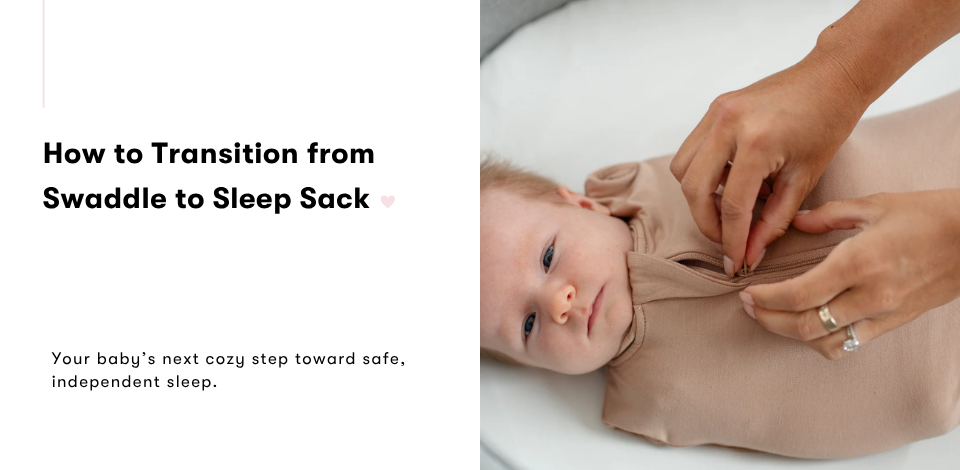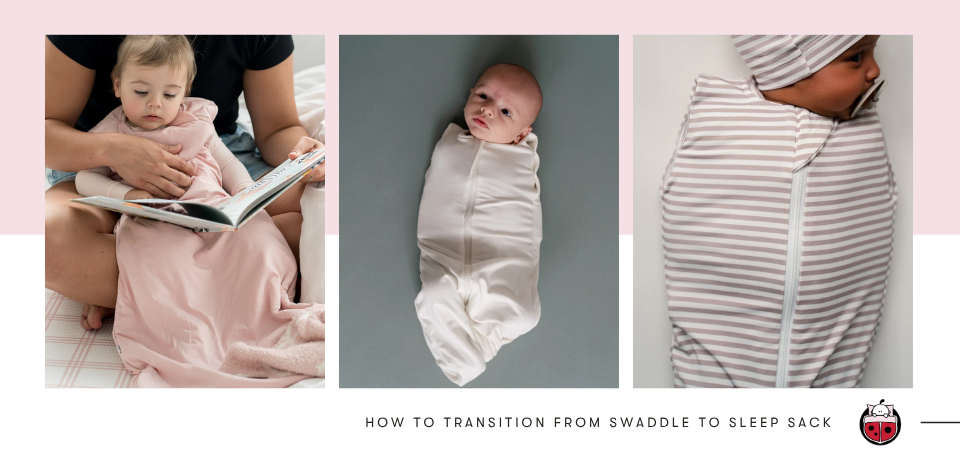How to Transition from Swaddle to Sleep Sack
Jump to Section

If you’re a parent of a newborn, you probably know the magic of a perfectly swaddled baby. Those tiny arms tucked in just right, a soft sigh, and finally — peaceful sleep. But as your baby grows, there comes a point when swaddling can actually become unsafe. Enter the sleep sack: your baby’s next cozy step toward safe, independent sleep.
Transitioning from a swaddle to a sleep sack can feel like a big leap, but with the right timing, tools, and a little patience, it’s completely doable. In this guide, we’ll walk you through everything from signs your baby is ready, to choosing the perfect sleep sack, to troubleshooting common challenges, all while keeping your baby safe and your sanity intact.
Why You Should Transition from a Swaddle to a Sleep Sack
Swaddling is amazing for newborns; it soothes the startle reflex, promotes longer stretches of sleep, and makes your baby feel secure. But here’s the deal: once your baby starts rolling over or breaking free from their swaddle, it’s time to make the switch. Swaddling a rolling baby can increase the risk of suffocation, which is why pediatricians and Health Canada recommend moving to a sleep sack at the right stage.
Sleep sacks, also known as wearable blankets, keep your baby warm and cozy without the risks of loose blankets in the crib. In fact, Health Canada does not recommend the use of a loose blanket until your little one transitions to a bed. Sleep sacks allow free movement of arms and legs, helping babies develop strength and coordination while still feeling secure. Many designs are breathable and suitable for year-round use, perfect for Canadian parents navigating both chilly winters and warm summer nights.
Signs Your Baby is Ready to Move to a Sleep Sack
Knowing when to transition is key. Watch for these signs:
- Rolling Over: If your baby can roll from back to tummy, it’s no longer safe to swaddle. This is one of the biggest cues for a switch.
- Escaping the Swaddle: When your baby frequently wiggles out or seems uncomfortable, a sleep sack may be more cozy than restrictive.
- Increased Movement at Night: Squirming, flailing arms, or waking more often can indicate your baby wants more freedom.
- Growth Spurts: Babies may suddenly feel cramped in a swaddle after a growth spurt, signalling it’s time for the next stage.
Recognizing these signs helps you make the move before bedtime becomes a battle, and it keeps your baby safe.
Choosing the Right Sleep Sack
Not all sleep sacks are created equal. Here’s what to look for when shopping:
- Size & Fit: A sleep sack should fit snugly around the shoulders and chest but allow legs to kick freely. Being too loose or too tight can interfere with a safe sleep.
- Fabric & Breathability: Choose lightweight cotton or organic muslin for summer, and thicker, cozy fabrics for colder months. Breathable materials reduce the risk of overheating.
- Temperature & TOG Ratings: TOG (Thermal Overall Grade) ratings help you match the sleep sack to room temperature, important for Canadian winters!
- Zipper vs. Snaps: Zippered sleep sacks are convenient for quick nighttime diaper changes, while snaps can provide extra adjustability.
- Ease of Cleaning: Machine-washable fabrics are a must for busy parents dealing with inevitable spills and diaper blowouts.
Pro Tip: Some sleep sacks come with sleeves that can be removed or added, letting you start with a “swaddle-style” sleep sack before fully freeing the arms. This is a great middle ground for cautious parents.

Step-by-Step Guide: How to Transition from Swaddle to Sleep Sack
1. Start Gradually
Don’t throw the swaddle out cold turkey. Start with one arm out, then both arms out, before fully moving to a sleep sack. This gradual approach helps your baby adjust to new sensations without a major bedtime battle.
2. Keep Familiar Comforts
Use the same crib or white-noise machine your baby is used to. Familiar smells and routines help signal bedtime, making the sleep sack feel more like a cozy upgrade than a scary change.
3. Time It Right
Avoid switching during illness, teething, or growth spurts, which can already disrupt sleep. Pick a period when your baby is generally content and following a consistent sleep routine.
4. Stick to Your Bedtime Routine
Bath, story, feeding, snuggles — keep bedtime rituals consistent. Predictable routines give babies confidence that everything is still familiar, even if their arms are no longer swaddled.
5. Be Patient
Night wakings are common during transitions. Some babies adjust in just a few nights, while others may take a week or two. Sleep experts recommend giving it at least 14 days of consistency to see real improvements; just a few short nights or even a week often isn’t enough time. Stay consistent, provide comfort, and resist the urge to revert to a full swaddle unless safety is a concern.
Common Mistakes Parents Make
- Swaddling Too Long: Waiting until your baby rolls over can put them at risk. Start transitioning proactively.
- Wrong Sleep Sack Size: Too small can feel constricting; too big can pose suffocation risks. Always check size charts.
- Skipping Routine: A new sleep sack alone isn’t enough. Keep consistent bedtime cues to signal it’s still “sleep time.”
- Overheating: Babies actually sleep best on the cooler side, so it’s important not to overdress them. Avoid layering too much under or over the sleep sack and instead stick to the TOG ratings [link article about TOG rating] for safe sleep. This helps keep your little one comfortable while reducing the risk of overheating.
Bonus Tips for Canadian Parents
- Winter Layering: Consider layering a long-sleeve onesie under a thicker sleep sack. Avoid loose blankets.
- Summer Comfort: Lightweight, breathable fabrics keep your baby cool in hot Canadian summers.
- Travel-Friendly: Many sleep sacks fold easily for car trips or visits to grandparents.
- Check for Certifications: Look for baby sleepwear certified to Canadian safety standards to ensure peace of mind.
FAQs New Parents Ask About Sleep Sacks
Can I use a sleep sack with a newborn?
Yes! Choose a newborn-sized sleep sack without sleeves or with optional sleeves. Ensure it fits snugly around the shoulders to prevent slipping over the face.
How long should my baby stay in a sleep sack?
Sleep sacks are typically safe until your baby transitions to a toddler bed or climbs out of the crib. Sizes go up to 24 months or more.
My baby wakes up more at night — what do I do?
Night wakings are normal during this transition. Stick with your bedtime routine, and offer gentle reassurance. Avoid reverting to swaddles once your baby is rolling.
Final Thoughts
Transitioning from a swaddle to a sleep sack is a milestone, but it’s one you can navigate confidently. Look for readiness signs, choose the right sleep sack for your baby’s size and Canadian climate, and introduce the change gradually with familiar routines.
While the first few nights may include some fussing, consistency, patience, and reassurance go a long way. Soon, your little one will be snuggled safely in their sleep sack, arms free, exploring the world in their dreams — and maybe even giving you a few extra hours of sweet, well-deserved rest.


